Students can access the CBSE Sample Papers for Class 12 Biology with Solutions and marking scheme Term 2 Set 4 will help students in understanding the difficulty level of the exam.
CBSE Sample Papers for Class 12 Biology Standard Term 2 Set 4 with Solutions
Time Allowed: 2 Hours
Maximum Marks: 40
General Instructions:
- All questions are compulsory.
- The question paper has three sections and 13 questions. All questions are compulsory.
- Section-A has 6 questions of 2 marks each; Section-B has 6 questions of 3 marks each; and Section-C has a case-based question of 5 marks.
- There is no overall choice. However, internal choices have been provided in some questions. A student has to attempt only one of the alternatives in such questions.
- Wherever necessary, neat and properly labeled diagrams should be drawn.
SECTION – A
(Section A has 6 Questions of 2 marks each.)
Question 1.
The following picture shows the roots of leguminous plants with root nodules harbouring a beneficial bacterium – Rhizobium.
How does Rhizobium acts as a biofertilizer and whg it is categorised as a symbiotic bacterium? (2)
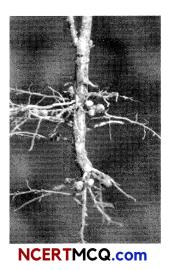
Answer:
Rhizobium is a symbiotic bacterium that resides in the nodules present on the roots of leguminous plants and fixes atmospheric nitrogen into nitrogenous compounds that can be utilised by plants as nutrients. Such a relationship is beneficial to both bacteria and plant and thus called as symbiotic relationship.
![]()
Question 2.
(A) Why an antibody molecule represented as H2L2?
(B) A person suffers from sustained high fever, weakness, constipation, headache and loss of appetite. Identify the disease from which the person is suffering and also name the diagnostic test which confirms this disease. (2)
Answer:
(A) An antibody has four peptide chains i.e., two small chains called as light (L) chains and two longer chains called as heavy (H) chains. Therefore, an antibody is represented as H2L2.
Related Theory
Antibodies are a class of proteins also called as immunoglobulins that are produced when an antigen attacks the body. The different types of antibodies produced in our body are IgA, IgM, IgE, IgC.
(B) The person is suffering from Typhoid. The diagnostic test that confirms typhoid is Widal test.
Question 3.
There is a growing trend of organic farming and nowadays everyone is preferring organic products over conventional ones. How organic farming is advantageous over conventional farming?
OR
Why Nucleopolyhedrovirus serve as excellent biocontrol agents? (2)
Answer:
The conventional farming involves practices that use chemical methods to kill both useful and harmful life forms indiscriminately, whereas organic farming is a holistic approach, that is based on an understanding of the webs of interaction between the myriad of organisms that constitute the field fauna and flora. Also in organic farming, the insects (pests) are not eradicated, but instead are kept at manageable levels by controlling them via natural predation rather than introducing chemicals.
OR
Nucleopolyhedrovirus are excellent for species-specific, narrow spectrum insecticidal applications. They have no negative impacts on plants, mammals, birds, fish or even on non-target insects, that is one of the desirable qualities in an overall integrated pest management (IPM), when beneficial insects are being conserved or when an ecologically sensitive area is being treated.
![]()
Question 4.
(A) Reema was studying about plasmids
and came across the term ‘marker gene’. What is the importance of a marker gene?
(B) Although the retroviruses cause severe diseases, yet they are efficiently used in genetic engineering experiments. Explain briefly how? (2)
Answer:
(A) Marker gene is used to determine that the
nucleic acid sequence has been successfully inserted into an organism’s DNA or not.
Related Theory
There are two sub-types of marker genes, i.e., a selectable marker and a screenable marker.
(B) When a retrovirus enters a host cell, it produces DNA from its RNA sequence with the help of an enzyme called reverse transcriptase. In genetic engineering experiments, the disease-causing gene is removed from retroviruses, therefore they can be used as vectors to deliver recombinant DNA into animal cells.
Related Theory
Retroviruses have RNA as their genetic material. Retrovirus DNA formed by reverse transcriptase is added to host cell genome, by an enzyme integrase. The retrovirus then continues to infect host celts and add genetic material to them, thus the retroviruses are useful in biotechnology to deliver desirable genes.
Question 5.
The Monarch Butterfly is avoided by predators and thus does not get eaten up. Why?
OR
Define commensalism and give one of its examples. (2)
Answer:
The Monarch Butterfly is avoided by predators because the butterfly is highly distasteful to its predator (birds). This butterfly has a special chemical in their body which they acquires during their caterpillar stage by feeding on a poisonous weed. These chemicals have fatal effect on the predator body.
Related Theory
During the larval stage monarch butterfly obtains nutrients by consuming milkweed leaves as its food, due to which it secretes a substance called cardiac glycosides, which have fatal effect on the predator body.
OR
The interaction where one species is benefitted and the other is neither benefitted nor harmed is called commensalism.
Example: An orchid growing as an epiphyte on a mango tree. The orchid gets shelter but derives no nutrition from the mango tree, while the mango tree is neither harmed nor benefitted.
![]()
Question 6.
The human activities are largely responsible
for the accelerated rates of species extinctions and the biological wealth of our planet has been declining rapidly. Mention any two human activities responsible for it. (2)
Answer:
The human activities that has led to loss of biodiversity are:
- Destruction of habitats of animals by humans.
- Over-exploitation of natural resources and their degradation.
- Alien species invasions: Through human activities, species of animals and plants have been introduced to new habitats all over the world. When these species manage to survive, they usually thrive and exclude native species through competition or predation.
- Hunting (Any two)
SECTION – B
(Section B has 6 Questions of 3 marks each.)
Question 7.
(A) The given picture shows a typical sewage
treatment plant. How is activated sludge produced during sewage treatment?
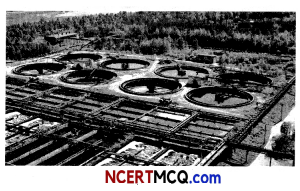
(B) During sewage treatment, the step of secondary treatment is called as biological treatment. Why? (3)
Answer:
(A) When the BOD (Biochemical Oxygen
Demand) of sewage or waste water is reduced significantly, the effluent is then passed into a settling tank where the bacterial ‘floes’ are allowed to sediment. This sediment is known as activated sludge.
(B) The secondary treatment is also known as biological Treatment because it involves the use of microbes (living organisms) for sewage treatment.
![]()
Question 8.
Reshma was studying about restriction enzymes and came across names of several restriction enzymes such as Sail, EcoRI, Pvul, etc. Describe the basic steps involved in the nomenclature of restriction enzymes.
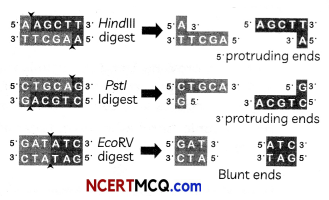
Answer:
The restriction enzymes are named in the following manner:
- The first letter of the name comes from the genus.
- The second two letters come from the species of the prokaryotic cell from which the enzymes were isolated.
Example: The restriction enzyme isolated from Escherichia coli RY 13 i.e., EcoRI – letter E comes from the genus Escherichia and the second two letters co comes from the species coli. - The letter ‘R’ is derived from the name of strain in EcoRI.
- Roman numbers following the names indicate the order in which the enzymes were isolated from that strain of bacteria.
Question 9.
A genetically modified or transgenic variety of rice was created in 1990s to improve human health. Name the variety and the reason for which it was created. Also briefly explain how it was made and by whom. (3)
Answer:
Golden rice is a genetically modified or transgenic variety of Oryza sativa (rice), that has been developed as a fortified food for areas where there is a shortage of dietary vitamin A. It contains a precursor of pro-vitamin A, known as (3-carotene, which is introduced in the rice with the help of genetic engineering. The rice grains are golden yellow in colour due to p-carotene and thus called Golden rice. It was developed at Swiss Federal Institute of Technology by Professor Ingo Potrykus and Peter Beyer.
Related Theory
Although rice plant produces beta-carotene pigment naturally in its leaves, but it is absent in the seed endosperm, as the pigment helps in photosynthesis and photosynthesis do not takes place in endosperm. Since beta-carotene is the precursor of pro-vitamin A, it is introduced in rice variety. Compared to other vitamin supplements, it is a simple and less- expensive alternative. However, it is still not available for human consumption because of significant opposition from environmental activities.
Caution
While writing about golden rice remember that naturally rice is devoid of vitamin A, it is incorporated by genetic engineering only.
![]()
Question 10.
(A) In our childhood, we have heard the story of Koel and Crow in which Koel lays her eggs in the nest of a Crow. What is this phenomenon called as? Explain briefly.
(B) Why coral reefs are specifically found in Tamil Nadu on the east coast of India? (3)
Answer:
(A) The phenomenon is called as brood parasitism. It is a type of parasitism in which one organism i.e., the parasitic bird lays its eggs in the nest of another organism (host) so that the host incubate them. The eggs of the parasitic bird have evolved to resemble the host’s egg in size and colour, so that the host bird cannot detect and eject the foreign eggs from the nest.
Example: The cuckoo (koel) acts as the parasite and the crow is the host during the breeding season (spring to summer).
(B) Coral reefs are specifically found in Tamil Nadu on the east coast of India because of high salinity, optimal temperature and less siltation, which are essential for the corals to colonise. If siltation and fresh water inflow are high, then corals do not colonise.
Related Theory
Siltation is the water pollution caused by soil erosion or sediment spill.
Question 11.
The German naturalist and geographer Alexander von Humboldt explored the wilderness of South American jungles. Based on his observations, he plotted a graph between species richness and area and gave the following relationship as shown in the graph below.
(A) What was his observation from the studies conducted?
(B) If Z represents the slope of the line (regression coefficient), then what is the significance of the slope of regression in a species – area relationship? (3)
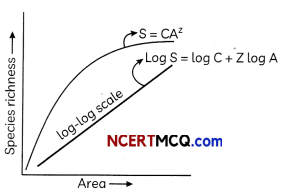
Showing species area relationship. Note that on log scale the realtionship becomes liner
Answer:
(A) Alexander von Humboldt observed that
within a region, species richness increased with increasing explored area, but only up to a limit.
(B) The species-area relationship is found out using the slope. Slope of regression or regression coefficient is used to measure species richness along an area. In smaller regions, an analysis of species-area relationship shows that the value of slope of regression is the same irrespective of the taxonomic assemblage or the region. Whereas when analysis is carried out in large areas the slope of regression was found to be much steeper.
![]()
Question 12.
Sunita is surprised to see that in most of the gene cloning experiments £ coli is used as the host. Give three reasons for the extensive use of E. coli.
OR
Which three critical research areas of biotechnology are there? (3)
Answer:
E. coli is used extensively as host because:
- It does not contain any elements that interfere with replication and recombination of DNA.
- It is easy to transform and grow.
- It supports replication of inserted DNA.
OR
Three critical research areas of biotechnology
- Best catalyst in the form of improved
- Optimal conditions through engineering for organism usually a microbe or pure a catalyst to act are created, enzyme is provided.
- The protein/organic compound are purified by downstream processing technologies.
SECTION – C
(Section C has a case-based question of 5 marks.)
Question 13.
Risha saw the poster given below pasted on a wall near her house. As she inquired about this from her mother, she told her that one should take precautions if he/she is suffering from common cold, etc., so that it does not spread to other people.
Based on this answer the questions that follow:

(A) To which category do the above shown disease/infection belong? Write any two modes of spread of such type of infection?
(B) What do you mean by droplet infection? Give two examples of disease that spread through droplet infection.
OR
Given below is the picture showing the legs of a person suffering from an infectious disease. Answer the questions that follow:
Based on this answer the questions that follow:
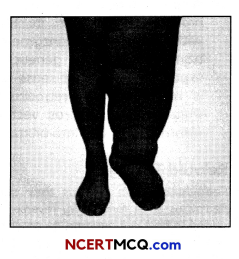
(A) Name the disease from which the person is suffering as shown in the picture.
(B) Which pathogen is responsible for causing the disease shown in the given picture?
(C) What is the mode of transmission of the disease shown in the picture?
(D) List any two symptoms of the disease depicted in the picture. (5)
Answer:
(A) The above shown disease/infection belongs to the category of infectious diseases. These are those diseases that are easily transmitted from one person to another via pathogens. These diseases are very common and every person suffers from them at some point of their life.
![]()
Example: AIDS, typhoid, common cold, etc. Infectious diseases spread through the following modes:
- Through air: The disease spread through droplets released in the air during sneezing or coughing Eg., common cold, tuberculosis.
- Through water: It can spread with intake of contaminated water, E.g., Cholera, Typhoid.
- Sexual contact: Can spread through sexual contact or the exchange of body fluids. Eg., Syphilis, AIDS.
- Through vectors: The infectious agent can be carried via animals like flies and mosquitoes from sick person to a healthy person. Eg., Rabies, Malaria
(Any two)
(B) Droplet infection: When a person sneezes or coughs, the droplets are released in the air that can spread the infection to other person. These droplets of an infected person either contain saliva, sputum or nasal discharge which may be breathed in by healthy people and cause infection in them. Airborne diseases can have a droplet mode of transmission.
Example: Common cold, Flu, Diphtheria, Plague, Rubella, Covid-19. (Any two)
OR
(A) Elephantiasis is the disease from which the person is suffering as shown in the given picture.
(B) The pathogen or causative agent responsible for Elephantiasis is Wuchereria bancrofti and Wuchereria malayi (filarial worms).
(C) The Elephantiasis or Filariasis disease is transmiteu by the vector female Culex mosquko.
(D) The symptoms of Elephantiasis/Filariasis are as follows:
- Slowly developing chronic inflammation of the organs infected by these worms which are usually lymphatic vessels of the lower limbs.
- The genital organs also get affected thus causing gross deformities.